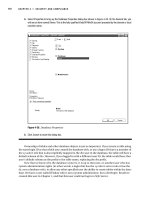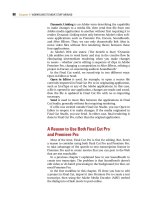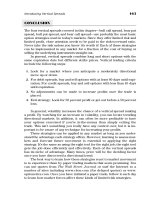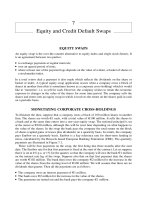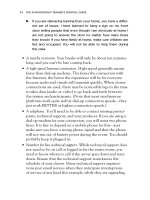STUDY GUIDE FOR COME INTO MY TRADING ROOM phần 4 pps
Bạn đang xem bản rút gọn của tài liệu. Xem và tải ngay bản đầy đủ của tài liệu tại đây (184.72 KB, 20 trang )
SEVEN
ADVANCED CONCEPTS
To succeed in trading, you need an advantage over your competitors.
The best edge is a very high level of discipline. Another good edge
comes from a deeper level of understanding of the markets. This is usu-
ally based on having unusual and original analytic tools, that are not
available to the mass of traders.
Successful traders tend to rely on private tools and techniques, or else
they use commonly known tools in uncommon ways. Here we will
review two new methods—the Impulse System for finding trades and
SafeZone for placing stops. We will also look at the derivatives—
options and futures. A beginner is better off staying away from them and
learning to trade stocks, but an experienced trader may expand his area
of interest to include derivatives.
53
Question 54—The Impulse System
Match the following phrases regarding the Impulse System:
1. The hardest thing about momentum trading
2. Reflects growing bullish momentum
3. Reflects bearish inertia
4. Reflects growing bearish momentum
5. Reflects bullish inertia
6. Waiting for confirmation
54 QUESTIONS
Questions Trial 1 Trial 2 Trial 3 Trial 4 Trial 5
54
55
56
57
58
59
60
61
62
63
64
65
66
67
Total points
A. Rising EMA
B. Rising MACD-Histogram
C. Reduces the profitability of a trade
D. Falling EMA
E. Knowing when to jump out of a trade
F. Falling MACD-Histogram
Question 55—The Impulse System
ADVANCED CONCEPTS 55
AB CDEFGH
Figure 7.1
The weekly chart is in an uptrend. Please review the daily chart in
Figure 7.1 and match the following signals with the letters in the chart.
1. Cluster of sell signals
2. Cluster of buy signals
And for extra credit:
At the right edge of the chart, bullish, bearish, or neutral? Please explain.
Question 56—The Impulse System
56 QUESTIONS
AB C D E F G
Figure 7.2
The 25-minute chart (not shown) is in a downtrend. Please review the
five-minute chart in Figure 7.2 and match the following signals with
the letters in the chart. Thick vertical bars mark the beginning and the
end of each trading session.
1. Cluster of buy signals
2. Cluster of sell signals
3. Downward gap
4. Breakout from the opening range
5. New extreme of bears’ strength
6. Bullish divergence
And for extra credit:
At the right edge of the chart, bullish, bearish, or neutral? Please explain.
Question 57—Exits
Which of the following statements about exits are correct?
1. Weigh risks and rewards by comparing the distances from the
entrance to the profit target and then to a stop level.
2. Traders tend to be more objective about exits before entering a trade.
3. The distance to the stop should be larger than that to the profit target.
4. The best time to plan an exit is when you are in the trade.
5. Once in place, the profit target never shifts.
A. 1
B. 1 and 2
C. 1, 2, and 3
D. 1, 2, 3, and 4
E. All of the above
Question 58—Exits
Which of the following statements on using channels for exits are correct?
1. Prices of securities always oscillate above and below value.
2. The wider the channel, the more attractive the trade.
3. Channels help traders sell above value and cover shorts at de-
pressed levels.
4. A well-drawn channel will nail down essentially all tops and bottoms.
5. A well-drawn channel contains 99% of prices for the past few months.
A. 1
B. 1 and 2
C. 1, 2, and 3
D. 1, 2, 3, and 4
E. All of the above
ADVANCED CONCEPTS 57
Question 59—Exits
58 QUESTIONS
ACDE
B
Figure 7.3
Review the chart in Figure 7.3 and match the following signals with
the letters in the chart.
1. Take profits on longs
2. Take profits on shorts
And for extra credit:
At the right edge of the chart, bullish, bearish, or neutral? Please explain.
Question 60—Stops
Which of the following statements regarding stops are true and which
are false?
1. The time to place a stop is immediately after entering a trade.
2. Superior market analysis makes stops unnecessary.
3. Mental stops are safer than those placed in the market.
4. Stops must be linked with money management rules.
5. Stops are defined by technical analysis.
Question 61—SafeZone
Match the following phrases and statements regarding SafeZone stops:
1. The trend is up; market noise is defined by
2. Multiply the Average Upside Penetration by a coefficient and add it
to the high.
3. The trend is down; market noise is defined by
4. Average Downside Penetration during the lookback period.
5. Multiply the Average Downside Penetration by a coefficient and
deduct it from the low.
6. Average Upside Penetration during the lookback period.
A. SafeZone stop in an uptrend
B. The extent by which today’s low is deeper than yesterday’s low
C. Average noise level in an uptrend
D. The extent by which today’s high exceeds yesterday’s high
E. SafeZone stop in a downtrend
F. Average noise level in a downtrend
ADVANCED CONCEPTS 59
Question 62—Trading on Margin
Which of the following statements about trading stocks on margin are
correct?
1. Allows you to leverage your buying power
2. Leads to greater losses on losing trades
3. More stressful than cash trades
4. Allows you to make bigger profits from correct decisions
5. Helps small traders make more profits and grow equity
A. 1
B. 1 and 2
C. 1, 2, and 3
D. 1, 2, 3, and 4
E. All of the above
Question 63—Trends and Swings
Which of the following statements apply to trend trading and which to
swing trading?
1. Channel width is relatively unimportant.
2. They are easy to trade.
3. You need to give trades some extra room with stops.
4. It is often done with the most active stocks.
5. Take profits at the channel line.
A. Trend trading
B. Swing trading
C. Neither
60 QUESTIONS
Question 64—Options
Option prices depend on all of the following, except:
1. Their distance to the exercise price
2. Their time to the expiration
3. Market trend
4. Interest rates
5. Stock volatility
Question 65—Options
With a stock trading at 65 in March, an options trader has several
choices. Match each choice with the position it describes:
1. Buy stock and sell 70 May call
2. Buy 60 May put
3. Sell 60 May put
4. Buy 60 May call and sell 60 July–May call
5. Buy 70 May call
A. Naked write
B. Covered write
C. Spread trade
D. Long call
E. Long put
ADVANCED CONCEPTS 61
Question 66—Options
Which of the following statements about option writing are correct?
1. Money management is the key requirement for writing options.
2. Writing naked options leads to limited reward with unlimited risk.
3. It is better to write puts when you are bullish.
4. A writer must wait for the expiration date to take profits.
5. Time is the enemy of the option writer.
A. 1
B. 1 and 2
C. 1, 2, and 3
D. 1, 2, 3, and 4
E. All of the above
Question 67—Futures
Match the following phrases regarding futures:
1. Taking a position in futures opposite to one’s position in the actual
commodity
2. The main source of risk in futures
3. Nearby months selling for more than faraway months
4. Industrial producers and consumers
5. Severe weather in production areas
A. Inverted market
B. Inside information
C. Supply-driven market
D. Hedging
E. Low margin requirements
62 QUESTIONS
EIGHT
MONEY MANAGEMENT
The third M of successful trading, Money, is certainly the most neglected.
Beginners spend a lot of time and energy trying to learn Methods, and
more experienced traders worry about their discipline and other topics
of the Mind, but only the pros pay enough attention to Money.
A professional understands that whether he trades an Internet high-
flyer, soybean futures, or IBM calls, he is ultimately trading money. Any
specific market is just a vehicle that may bring him a higher return than
a bank. This is why counting money is no less important—perhaps more
important—than counting indicator readings.
Have you noticed how, in trading, everything that can go wrong
tends to go wrong? There are legions of people making a living in the
markets, and they make money when you stumble. Every imaginable
banana peel gets thrown in your path. To protect yourself from losses,
you need to establish and religiously observe money management rules.
Money management provides a safety net on your journey to that
appealing land where you will be free because you trade for a living. If
you have a reasonably good method for analyzing the markets and find-
ing trades, you will succeed, if—and this is a very big if—you can protect
your capital along the way.
To underscore the extreme importance of money management, your
answers will be graded differently in this chapter. There will be no
“fairly good” rating. You must obtain an Excellent score because the
only other rating is Poor. Poor in more ways than one.
63
Question 68—Mathematical Expectation
A trading system has a positive mathematical expectation when it:
1. Makes money on most trades
2. Has more winning trades than losing
3. Guarantees profits
4. Works well without money management
5. Gives you an edge in the market
64 QUESTIONS
Questions Trial 1 Trial 2 Trial 3 Trial 4 Trial 5
68
69
70
71
72
73
74
75
76
77
78
79
80
81
82
Total points
Question 69—Numerical Literacy
Test your arithmetic skills, calculate the answers in your head, and write
down the answers:
1. 187 + 346
2. 12% of 200
3. 345 divided by 5
4. 37.5 multiplied by 500
5. The chance of snow is 25% on Saturday and 25% on Sunday. What
is the chance of snow during the entire weekend?
Question 70—The 2% Rule
Following the 2% Rule means:
1. Buying no more than $2,000 worth of stock in a $100,000 account
2. Risking no less than $400 in a $20,000 account
3. Risking no more than $3,000 in a $150,000 account
4. Aiming for at least a $2,000 profit in a $100,000 account
5. Aiming for at least a $2 profit per share in a $100 stock
MONEY MANAGEMENT 65
Question 71—The 2% Rule
Which of the following trades may be taken in a $50,000 account? (Re-
member, try to answer without a calculator.)
1. Buy 500 shares of a $25 stock, with a stop at $23.50
2. Sell short 300 shares of a $48 stock, with a stop at $51
3. Buy 1,000 shares of a $12 stock, with a stop at $11
4. Sell short 200 shares of a $92 stock, with a stop at $98
5. Buy 700 shares of a $33 stock, with a stop at $31
A. 1
B. 1 and 2
C. 1, 2, and 3
D. 1, 2, 3, and 4
E. All of the above
Question 72—Businessman’s Risk
Which of the following exposes you to a businessman’s risk and which
to risk of a loss?
1. $100,000 account, buy 1,000 shares of a $50 stock, stop at $48.75
2. $20,000 account, buy 300 shares of a $30 stock, stop at $28
3. $20,000 account, buy 200 shares of a $20 stock, stop at $18.50
4. $100,000 account, buy 1,000 shares of a $40 stock, stop at $36
5. $100,000 account, buy 1,000 shares of a $50 stock, no stop
A. Businessman’s risk
B. Risk of loss
66 QUESTIONS
Question 73—The 2% Rule
Bill is a beginning stock trader with a $25,000 account. He selects a $40
stock that he expects to rally to $48, and wants to place a stop at $36,
below support. He wants to trade a round lot of 100 shares. Can he afford
to take this trade?
Question 74—The 2% Rule
Gary is a beginning futures trader with $20,000 in his account. He
wants to sell short gold, which he expects to fall by $9 per ounce. If
gold rallies $3 per ounce, it will cancel his downtrend scenario and
trigger a stop. There are 100 ounces of gold in each contract. Can he
afford to take this trade?
Question 75—The 2% Rule
Susan is a stock trader with $50,000 in her account. She selects a $24
stock that she expects to rise to $30. She identifies support at $22 and
wants to place a stop at $21.50. She plans to buy 500 shares. Can she
afford to take this trade?
Question 76—Private and Institutional
The main reason institutional traders tend to do better than private
traders is:
1. More capital
2. Built-in support network of other traders
3. Having a manager
4. Better training
5. Less stress trading other people’s money
MONEY MANAGEMENT 67
Question 77—The 6% Rule
Following the 6% Rule means:
1. Aim to make 6% profit per month in your account.
2. Stop trading for the rest of the month after losing 6% of equity.
3. Keep your profit/loss ratio at 6:2.
4. Close out all position after risk exceeds 6%.
5. Never have more than three open trades if you follow the 2% Rule.
Question 78—The 6% Rule
Ann starts the month with $90,000. She puts on trades A and B, risk-
ing $1,200 on each, and loses. She then puts on trades C and D, risking
$1,500 on each, and moves stops on both to breakeven. Now she sees
trade E and wants to buy 500 shares, risking $3 on each. May she take
this trade?
Question 79—The 6% Rule
Peter starts the month with $150,000. He has several winning trades,
and then loses $2,500 on each of two trades in a row. He now has two
open trades of 1,000 shares each, with stops $1.90 and $1.70 away
from his entry prices. He recognizes an extremely attractive trading
opportunity on his screen. May he take it?
Question 80—The 6% Rule
Jim starts the month with $30,000. He puts on trades A, B, and C, risk-
ing $500 in each. Trades A and C reach his profit targets; trade B sinks
and hits his stop. He sees potential trades D and E, with the risk of $500
on each of them. May he take them?
68 QUESTIONS
Question 81—Position Sizing
Which of the following statements are true and which are false?
1. The smaller the trade, relative to account size, the more likely it is
to be profitable.
2. When losing, it is important to increase the size of trades to make
back losses.
3. The amount of risk has a direct impact on the quality of trading
decisions.
4. If you aim for big profits, survival will come naturally.
5. The amount at risk is more important than trade size in making
decisions.
Question 82—Position Sizing
Which of the following is most indicative of overtrading in a $100,000
account?
1. Putting on three trades a day
2. Having 10 open positions with $750 risk in each
3. 10 trades a week
4. Trading 5,000-share lots
5. Having five open positions with $1,000 risk in each
MONEY MANAGEMENT 69
NINE
THE ORGANIZED TRADER
If you have worked through this book so far, you appreciate that trading
is a serious pursuit. It requires the utmost concentration, attention, and
dedication. You may mean well, but how can you be sure that your
actions follow your intentions? You want to avoid having to say, like a
former Russian prime minister, “We wanted the best, but got the usual.”
Or, as my grandfather used to say, “The road to Hell is paved with good
intentions.”
The only way to tell whether you are on the right track is by keeping
good notes. Show me a trader with good notes, and I will show you a
good trader.
Keeping extensive records and reviewing them is a lot less fun than
swinging in the markets, buying here and selling there. Good records
provide the best running test of your level of discipline. If you score
high on that test—not just in this book, but after you are finished work-
ing with it, in your own trading—you should do well and succeed in
trading for a living.
Grading in this chapter, as in the Money Management chapter, is
different from the rest of this book. This topic is so important that there
is no “fairly good” rating. You must keep learning until you score
Excellent.
71
72 QUESTIONS
Questions Trial 1 Trial 2 Trial 3 Trial 4 Trial 5
83
84
85
86
87
88
89
90
91
92
93
94
95
96
97
98
99
100
Total points



